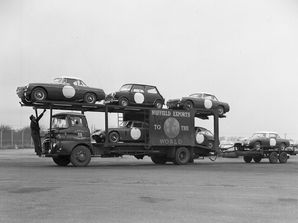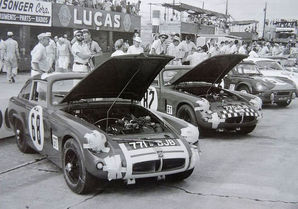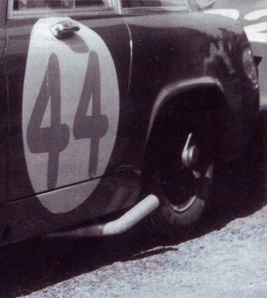The Raison d'Etre
Dick Jacobs grew up in South Woodford in Essex, at his father's motor business, Mill Garage. He inevitably developed a keen interest in cars and while still serving in the Royal Navy at the end of World War 2 he wrote to the MG Car Company asking whether they would give him an agency. After being de-mobbed he bought himself a new MG TC to which he fitted a supercharger and was soon taking part in competitive events including club racing. His MG dealership prospered and because of his racing he got to know those at MG who were resposible for development and performance. These included Syd Enever, John Thornley and Marcus Chambers all of whom became close friends over the coming years.
Fast forwarding now to 1955 and Jacobs was invited by Thornley to drive for MG in the Le Mans 24 Hours. The car was a prototype of the MGA which was to be announced to the public on the same weekend. The raced was marred by the serious accident in which a Mercedes was catapulted into the crowd with considerable loss of life. Dick Jacobs had the misfortune to crash shortly afterwards. He was badly injured but over the coming months made a gradual recovery. However the result was an end to his motor racing days.
Unable to leave the racing game completely behind him he put his knowledge and experience to good use by going into team management. By 1958 he was running a pair of MGA Twin Cams for Alan Foster and Tommy Bridger who take part in 15 races that season. When the cars became out-classed by Lotus Elites and Porsches Jacobs decide to sell them, and in consequence was left without a racing team for the subsequent years.
1961 brought the introduction of the new MG Midget and in Dick Jacobs' own words, taken from his book, "an MG experience" he tells us:
"Early in the year...........the first catalogues of the new MG Midget arrived. I noticed the small side elevation of the car. This did not appear to be to any set scale but was used to show the overall measurements such as height and length. By pure chance I had on my desk a 'Motor' road test of the original Aston Martin DB4 and I noticed the overall length of a similar drawing for the DB4 was the same as the MG Midget drawing. I took a tracing of the Aston Martin outline and laid it on the MG Midget and I had the silhouette of an MG Midget coupé.
Armed with this pleasing shape, I visited John Thornley at Abingdon, who was enthusiastic and made a lot of encouraging noises. Syd Enever was called in and he too was interested. The drawing office lads* had done a rough sketch before I left and Syd Enever was asked by John Thornley to go ahead. As bumpers were not required by racing regulations, Syd designed a new nose-piece (left) with better air penetration qualities. Wind tunnel tests showed that, at 100 mph, the Midget in this form required 13 bhp less than the production car, although the basic shape from headlamp to tail lamp and from the top of the doors down was standard. With aluminium bodywork throughout and the removal of all un-necessary weight, the car weighed 11 cwts. As production of these rather special cars involved many departments, it was obvious that 1962 would have to be our first season".


The attractive lines of the body shape were penned by Jim (James Edward) O'Neill (see "Working inside the Octagon" by David Knowles, 1994)
Design and Assembly
Bill Price mentions in his book "The BMC/BL Competition Department" that the project was 'undertaken by the MG Development Department under Syd Enever.......The shape of the aluminium bodies was developed from wind tunnel tests with the structure based on the steel production Midget floorpan. The aluminium panels were assembled using a combination of epoxy resin and rivets, the final weight being over 300 lbs lighter than a production Midget. Two of the cars were loaned to Dick Jacobs who raced them successfully, mainly in club events, but at the end of 1964 they were returned to the factory....'
The aluminium fabrication was carried out by a family firm of coach builders and a team of five craftsmen who fashioned the panels and put the bodies together. Bob Smith, who went on to found his own business, RS Panels of Nuneaton, which he runs with his son, was one of the five. They now re-create fabulous Aston Martins, Ferraris and other exotica.
The car bodies were constructed using a wooden former, which it is believed still exists, on which the aluminium panels were shaped before being appied to the chassis. Recently a drawing of the car came to light, having been purchased on eBay by Tim Hornby who brought it along to MG Live at Silverstone in June 2010. I have since had the opportunity of viewing it and it seems to be an early outline drawing with little detail. However one can see the steeply raked windscreen, rounded nose-cone and fastback tail with which we are now familiar.
An announcement in Autosport on June 15th, 1962 revealed:
"Dick Jacobs Returns to Racing"
And on 30th July, 1962 Bill Price of BMC Competitions Department wrote this letter to Dick Jacobs regarding the homologation of the Lockheed disc brakes and wire wheels fitted to these cars.


Back to Abingdon
As Bill Price explains in his book "The BL/BMC Competition Department":
"One project undertaken by the MG Development Department under Syd Enever which was eventually to be of benefit to the Competitions Department was the construction in 1962 of three MG Midget Coupés. The shape of the aluminium bodies was developed from wind tunnel tests with the structure based on the steel production Midget floorpan. The aluminium panels were assembled using a combination of epoxy resin and rivets, the final weight being over 300lbs lighter than a production Midget. Two of the cars wewre loaned to Dick Jacobs who raced them successfully mainly in club events but at the end of 1964 they were returned to the factory where we took them over and prepared them for the 12 Hour Race at Sebring".
Body modifications:
The cars were now fitted with jacking points at front and rear, for quick-lift jacks, and a pair of small additional rear lights. At the front, the MGB style side-flasher lamps were changed to small flashing indicators, the side-lights then being incorporated within the headlights. This gave enough space for recesses to be formed in the front bodywork to house a pair of spotlights. The spots were later removed and the apertures fitted with covers. The air outlets in the sides of the front wings had been added sometime between the '62 and '63 seasons' racing. Another minor mod' was the aluminium gutter fitted above the rear window.
Sebring 12 Hours - 27th March 1965
One of the cars (No.68) was entered for Andrew Hedges and Roger Mac, while sharing the other (No.82) were Chuck (Charles) Tannlund and John Wagstaff. The 68 car came home 26th while the Tannlund/Wagstaff car retired after only 7 laps with a con-rod failure. Bill Price describes how after 10 hours "the sky then darkened and the heavens opened with a storm the like of which the locals had not seen before. Within minutes the track and pits were under water, but to everyone's amazement the race was not stopped".
The 1965 Targa Florio
Drivers: Paddy Hopkirk/Andrew Hedges (No.44) Team Principal: Dick Jacobs They finished 11th overall and 2nd in class to an Abarth-Simca. At the finish they were still on the same lap as the winning Ferrari 275 P2 of Vaccerella and Bandini.
The 1965 Nurburgring 1000kms (770 BJB) - 23rd May
Drivers: Andrew Hedges/Keith Greene (No.98) finished 27th and 4th in class.
After this final season of competition the cars were finally laid up in 1966 before being offered to Syd Beer in whose family they remain to this day. For the full story see Dennis Wharf's excellent article published in Safety Fast in 2011.









